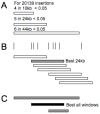TAPDANCE: an automated tool to identify and annotate transposon insertion CISs and associations between CISs from next generation sequence data
- PMID: 22748055
- PMCID: PMC3461456
- DOI: 10.1186/1471-2105-13-154
TAPDANCE: an automated tool to identify and annotate transposon insertion CISs and associations between CISs from next generation sequence data
Abstract
Background: Next generation sequencing approaches applied to the analyses of transposon insertion junction fragments generated in high throughput forward genetic screens has created the need for clear informatics and statistical approaches to deal with the massive amount of data currently being generated. Previous approaches utilized to 1) map junction fragments within the genome and 2) identify Common Insertion Sites (CISs) within the genome are not practical due to the volume of data generated by current sequencing technologies. Previous approaches applied to this problem also required significant manual annotation.
Results: We describe Transposon Annotation Poisson Distribution Association Network Connectivity Environment (TAPDANCE) software, which automates the identification of CISs within transposon junction fragment insertion data. Starting with barcoded sequence data, the software identifies and trims sequences and maps putative genomic sequence to a reference genome using the bowtie short read mapper. Poisson distribution statistics are then applied to assess and rank genomic regions showing significant enrichment for transposon insertion. Novel methods of counting insertions are used to ensure that the results presented have the expected characteristics of informative CISs. A persistent mySQL database is generated and utilized to keep track of sequences, mappings and common insertion sites. Additionally, associations between phenotypes and CISs are also identified using Fisher's exact test with multiple testing correction. In a case study using previously published data we show that the TAPDANCE software identifies CISs as previously described, prioritizes them based on p-value, allows holistic visualization of the data within genome browser software and identifies relationships present in the structure of the data.
Conclusions: The TAPDANCE process is fully automated, performs similarly to previous labor intensive approaches, provides consistent results at a wide range of sequence sampling depth, has the capability of handling extremely large datasets, enables meaningful comparison across datasets and enables large scale meta-analyses of junction fragment data. The TAPDANCE software will greatly enhance our ability to analyze these datasets in order to increase our understanding of the genetic basis of cancers.
Figures








Similar articles
-
Transmicron: accurate prediction of insertion probabilities improves detection of cancer driver genes from transposon mutagenesis screens.Nucleic Acids Res. 2023 Feb 28;51(4):e21. doi: 10.1093/nar/gkac1215. Nucleic Acids Res. 2023. PMID: 36617985 Free PMC article.
-
RNA sequencing of Sleeping Beauty transposon-induced tumors detects transposon-RNA fusions in forward genetic cancer screens.Genome Res. 2016 Jan;26(1):119-29. doi: 10.1101/gr.188649.114. Epub 2015 Nov 9. Genome Res. 2016. PMID: 26553456 Free PMC article.
-
Sequencing methods and datasets to improve functional interpretation of sleeping beauty mutagenesis screens.BMC Genomics. 2014 Dec 19;15(1):1150. doi: 10.1186/1471-2164-15-1150. BMC Genomics. 2014. PMID: 25526783 Free PMC article.
-
Transposon sequencing: methods and expanding applications.Appl Microbiol Biotechnol. 2016 Jan;100(1):31-43. doi: 10.1007/s00253-015-7037-8. Appl Microbiol Biotechnol. 2016. PMID: 26476650 Review.
-
Transposon mutagenesis in oral streptococcus.J Oral Microbiol. 2022 Jul 24;14(1):2104951. doi: 10.1080/20002297.2022.2104951. eCollection 2022. J Oral Microbiol. 2022. PMID: 35903085 Free PMC article. Review.
Cited by
-
Transposon mutagenesis identifies candidate genes that cooperate with loss of transforming growth factor-beta signaling in mouse intestinal neoplasms.Int J Cancer. 2017 Feb 15;140(4):853-863. doi: 10.1002/ijc.30491. Epub 2016 Nov 7. Int J Cancer. 2017. PMID: 27790711 Free PMC article.
-
Modulation of the intrinsic chromatin binding property of HIV-1 integrase by LEDGF/p75.Nucleic Acids Res. 2021 Nov 8;49(19):11241-11256. doi: 10.1093/nar/gkab886. Nucleic Acids Res. 2021. PMID: 34634812 Free PMC article.
-
Modulation of the functional association between the HIV-1 intasome and the nucleosome by histone amino-terminal tails.Retrovirology. 2017 Nov 28;14(1):54. doi: 10.1186/s12977-017-0378-x. Retrovirology. 2017. PMID: 29179726 Free PMC article.
-
A native, highly active Tc1/mariner transposon from zebrafish (ZB) offers an efficient genetic manipulation tool for vertebrates.Nucleic Acids Res. 2021 Feb 26;49(4):2126-2140. doi: 10.1093/nar/gkab045. Nucleic Acids Res. 2021. PMID: 33638993 Free PMC article.
-
Canonical Wnt/β-catenin signaling drives human schwann cell transformation, progression, and tumor maintenance.Cancer Discov. 2013 Jun;3(6):674-89. doi: 10.1158/2159-8290.CD-13-0081. Epub 2013 Mar 27. Cancer Discov. 2013. PMID: 23535903 Free PMC article.
References
-
- Starr TK, Allaei R, Silverstein KAT, Staggs RA, Sarver AL, Bergemann TL, Gupta M, O’Sullivan MG, Matise I, Dupuy AJ, Collier LS, Powers S, Oberg AL, Asmann YW, Thibodeau SN, Tessarollo L, Copeland NG, Jenkins NA, Cormier RT, Largaespada DA. A transposon-based genetic screen in mice identifies genes altered in colorectal cancer. Science. 2009;323:1747–1750. doi: 10.1126/science.1163040. - DOI - PMC - PubMed
-
- Keng VW, Villanueva A, Chiang DY, Dupuy AJ, Ryan BJ, Matise I, Silverstein KAT, Sarver A, Starr TK, Akagi K, Tessarollo L, Collier LS, Powers S, Lowe SW, Jenkins NA, Copeland NG, Llovet JM, Largaespada DA. A conditional transposon-based insertional mutagenesis screen for genes associated with mouse hepatocellular carcinoma. Nat. 2009;27:264–274. doi: 10.1038/nbt.1526. - DOI - PMC - PubMed
MeSH terms
Substances
Grants and funding
LinkOut - more resources
Full Text Sources

